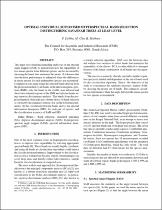 ResearchSpace
ResearchSpace
Optimal individual supervised hyperspectral band selection distinguishing savannah trees at leaf level
JavaScript is disabled for your browser. Some features of this site may not work without it.
- ResearchSpace
- →
- Research Publications/Outputs
- →
- Conference Publications
- →
- View Item
| dc.contributor.author |
Debba, Pravesh

|
|
| dc.contributor.author |
Cho, Moses A

|
|
| dc.contributor.author |
Mathieu, Renaud SA

|
|
| dc.date.accessioned | 2009-09-21T13:56:11Z | |
| dc.date.available | 2009-09-21T13:56:11Z | |
| dc.date.issued | 2009-08 | |
| dc.identifier.citation | Debba, P., Cho, M.A. and Mathieu, R. 2009. Optimal individual supervised hyperspectral band selection distinguishing savannah trees at leaf level. Evolution in remote sensing. IEEE GRSS First Workshop on Hyperspectral Image and Signal, Grenoble, France, 26-28 August, 2009. pp 1-4 | en |
| dc.identifier.isbn | 978-1-4244-4948-4 | |
| dc.identifier.uri | http://hdl.handle.net/10204/3612 | |
| dc.description | Evolution in remote sensing. IEEE GRSS First Workshop on Hyperspectral Image and Signal, Grenoble, France, 26-28 August, 2009 | en |
| dc.description.abstract | This paper uses simulated annealing and focus on the spectral angle mapper (SAM), to demonstrate how the separability of two mean spectra from different species can be increased by choosing the bands that maximize the metric. It is known that classification performance is enhanced when the differences in mean spectra for each endmember species are maximized. Comparison was made using the selected bands derived from the proposed method, to all bands in the electromagnetic spectrum (EMS), only the bands in the visible, near infrared and short wave infrared regions of the EMS and selected bands using stepwise discriminant analysis. The bands from the proposed method often indicates a better choice of band selection as viewed by the summary statistics for (a) the SAM measurements, (b) the correlations between bands and (c) the spectral information divergence (SID), for each pair of species; and the classification accuracy of SAM and SID. | en |
| dc.language.iso | en | en |
| dc.publisher | IEEE | en |
| dc.subject | Band selection | en |
| dc.subject | Savannah trees | en |
| dc.subject | Simulated annealing | en |
| dc.subject | Stepwise discriminant analysis | en |
| dc.subject | SDA | en |
| dc.subject | Hyperspectral | en |
| dc.subject | Spectral angle mapper | en |
| dc.subject | SAM | en |
| dc.subject | Spectral information divergence | en |
| dc.subject | SID | en |
| dc.subject | Remote sensing | en |
| dc.subject | Electromagnetic spectrum | en |
| dc.subject | Hyperspectral image | en |
| dc.subject | Hyperspectral signal | en |
| dc.title | Optimal individual supervised hyperspectral band selection distinguishing savannah trees at leaf level | en |
| dc.type | Conference Presentation | en |
| dc.identifier.apacitation | Debba, P., Cho, M. A., & Mathieu, R. S. (2009). Optimal individual supervised hyperspectral band selection distinguishing savannah trees at leaf level. IEEE. http://hdl.handle.net/10204/3612 | en_ZA |
| dc.identifier.chicagocitation | Debba, Pravesh, Moses A Cho, and Renaud SA Mathieu. "Optimal individual supervised hyperspectral band selection distinguishing savannah trees at leaf level." (2009): http://hdl.handle.net/10204/3612 | en_ZA |
| dc.identifier.vancouvercitation | Debba P, Cho MA, Mathieu RS, Optimal individual supervised hyperspectral band selection distinguishing savannah trees at leaf level; IEEE; 2009. http://hdl.handle.net/10204/3612 . | en_ZA |
| dc.identifier.ris | TY - Conference Presentation AU - Debba, Pravesh AU - Cho, Moses A AU - Mathieu, Renaud SA AB - This paper uses simulated annealing and focus on the spectral angle mapper (SAM), to demonstrate how the separability of two mean spectra from different species can be increased by choosing the bands that maximize the metric. It is known that classification performance is enhanced when the differences in mean spectra for each endmember species are maximized. Comparison was made using the selected bands derived from the proposed method, to all bands in the electromagnetic spectrum (EMS), only the bands in the visible, near infrared and short wave infrared regions of the EMS and selected bands using stepwise discriminant analysis. The bands from the proposed method often indicates a better choice of band selection as viewed by the summary statistics for (a) the SAM measurements, (b) the correlations between bands and (c) the spectral information divergence (SID), for each pair of species; and the classification accuracy of SAM and SID. DA - 2009-08 DB - ResearchSpace DP - CSIR KW - Band selection KW - Savannah trees KW - Simulated annealing KW - Stepwise discriminant analysis KW - SDA KW - Hyperspectral KW - Spectral angle mapper KW - SAM KW - Spectral information divergence KW - SID KW - Remote sensing KW - Electromagnetic spectrum KW - Hyperspectral image KW - Hyperspectral signal LK - https://researchspace.csir.co.za PY - 2009 SM - 978-1-4244-4948-4 T1 - Optimal individual supervised hyperspectral band selection distinguishing savannah trees at leaf level TI - Optimal individual supervised hyperspectral band selection distinguishing savannah trees at leaf level UR - http://hdl.handle.net/10204/3612 ER - | en_ZA |





